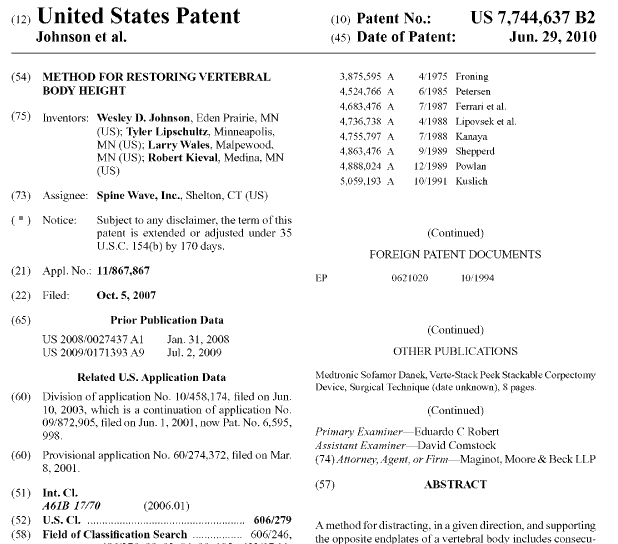Me: This invention is a low invasive surgical procedure which flat implants are systematically inserted into the subject’s vertebral bone through a stacking process which decompresses possible vertebral fractures that develop from bone degeneration. It is a type of vertebroplasty. There is an initial implant of a top and bottom plate, and then the real implant is placed between them. This implant is expandable but not inflatable. It expands only in the spinal axis direction thus pushing apart the top and bottom plates and supporting them. This causes the vertebral to expand and widen, thus increasing vertebral height. Once you get the implant next to the cancellous bone, you inject a bone filler ,which is body cement into the implant.
The way the implants are stacked upon each other is similar to the game of Jenga with the blocks but there is a locking mechanism which holds the pieces in place
I must say that this approach has minimal invasiveness and the invention will lead to even more ideas in this small area of surgery.
Patent Link found HERE.
| A method for distracting, in a given direction, and supporting the opposite endplates of a vertebral body includes consecutively inserting a plurality of wafers between the endplates to create a column of wafers. The column of wafers is oriented between the endplates so as to expand in the given direction as the wafers are consecutively added to the column to restore the vertebral body height.
Inventors: Wesley D. Johnson, Tyler Lipschultz, Larry Wales, Robert Kieval
Original Assignee: Spine Wave, Inc. Primary Examiner: Eduardo C Robert Secondary Examiner: David Comstock Attorney: Maginot, Moore & Beck LLP Current U.S. Classification: 606/279 |
Patent number: 7744637
Filing date: Oct 5, 2007
Issue date: Jun 29, 2010
Application number: 11/867,867


hi, this sounds interesting method of height increase, especially as a method seems to give up the torso, which gives a greater proportion of that possibility exists that this applies to increased torso?
Hi, can this method also be used in case of “old” vertebral compression fractures?
It should work. To heal old fractures you can always choose between multiple choices. Are you experiencing some kind of back pain?
Well yes. I’ve been diagnosed with osteoporosis as a side effect of an intensive treatment with corticoids. I have had multi vertebral compression fractures and I lost around 4 inches of height… I have been intensively researching on the different methods of vertebral height restoration and it looks like all of them are only applicable on “fresh” factures…
there should be no difference between fresh or old fractures. an old fracture is just that the bones tried to heal and they did not heal properly leading to deformity or unsealed fractures. All a surgeon has to do is to make an incision around the area the bone tried to fuse around, remove that part creature new fractures, and new BMPs to close it with some bone implant. BMP6, BMP7 with Statin and LIPUS should heal almost all fractures. of course I don’t know how badly your fractures are and we are talking about the vertebrate not a regular bone. have they tried the idea of possibly putting a stenosis rod inside or Poly(methyl methacrylate to achieve more stability ?
I have discussed the option of PMMA and kyphoplasty with the last surgeon I consulted. After seeing my MRI scans, he said that as long as my fractures have healed (even if the pain still there) the procedure wont be effective. It seems that it won’t be easy to find a surgeon familial with one of those methods who will accept to treat my case. But am not losing hope:I GOT to find a solution…
i guess my next question is do you want to remove the pain or regain the height? they are both very hard to do. if you want to regain the height through kyphoplasty then it may be very difficult. with the pain, you can always try eastern medicine like acupuncture and homeopathy.
how old are you by the way?
I have discussed the option of PMMA and kyphoplasty with the last surgeon I consulted. After seeing my MRI scans, he said that as long as my fractures have healed (even if the pain still there) the procedure wont be effective. It seems that it won’t be easy to find a surgeon familial with one of those methods who will accept to treat my case. But am not losing hope:I GOT to find a solution…
Sorry I didn’t mean to post the previous message twice
Hi
My enquiry is similar to Anna’s except that I am a 36yr old mail and do not suffer from bone density issues. My L1 vertebra has an anterior compression fracture caused by a fall from height. The injury occurred 6years ago and I am otherwise healthy.
The fracture healed well and 3 months after the injury all pain was gone. I have slight numbing in the lower back but it is surface only and does not cause me concern. I only suffer discomfort now if I do things like running or heavy lifting. Swimming and low impact activities have no effect. I would like to skydive and parachute but am concerned by the impact of landings. The compression causes an unnatural curve to my spine and that does cause discomfort, but I am not in any pain. I am concerned that as I get older I may suffer more.
I am investigating non-surgical procedures but am also very interested in what surgical procedures are available. Kyphoplasty seems like a wonderful treatment to restore curvature and the vertebral height between the vertebrae above & below. But, like Anna, all the articles I can find on this recommend the procedure is done on the vertebra before it has healed.
Which is why this article caught my attention, particularly your comment above.
*male*